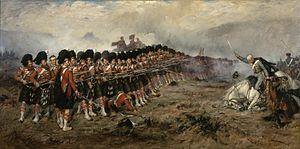Result British victory | Date 25 October 1854 Location Balaklava, Ukraine | |
 | ||
Combatants Similar | ||
The thin red line balaclava 1854
The Thin Red Line was a military action by the British Sutherland Highlanders 93rd (Highland) Regiment at the Battle of Balaklava on 25 October 1854, during the Crimean War. In this incident, the 93rd, aided by a small force of 100 walking wounded, 40 detached Guardsmen, and some Turkish infantrymen, led by Sir Colin Campbell, routed a Russian cavalry charge. Previously, Campbell’s Highland Brigade had taken part in actions at the Battle of Alma and the Siege of Sevastopol. There were more Victoria Crosses presented to the Highland soldiers at that time than at any other. The event was lionized in the British press and became an icon of the qualities of the British soldier in a war that was poorly managed and increasingly unpopular.
Contents
The battle
The Russian cavalry force of 2,500 was on the road to Balaklava. About 400 of them were involved in the incident. It was early morning, and the sole force that lay between the oncoming cavalry and the disorganised and vulnerable British camp was the 93rd Regiment.
Colin Campbell, 1st Baron Clyde is said to have told his men, "There is no retreat from here, men. You must die where you stand." Sir Colin's aide John Scott is said to have replied, "Aye, Sir Colin. If needs be, we'll do that." (Campbell's relationship with his men was almost family-like.) Campbell formed the 93rd into a line two deep — the "thin red line". Convention dictated that the line should be four deep. However, Campbell, a veteran of 41 years military service, had such a low opinion of the Russian cavalry that he did not bother to form four lines, let alone a square, but met the charge head on with the 2-deep firing line. As the Russian cavalry approached, the 93rd discharged three volleys: at 600, 350 and 150 yards respectively, however they did not get a chance to discharge one at point-blank (as at Minden in 1759) range as in popular belief. This is due to the fact that the Russian commander, seeing such a thin line of infantry, concluded that this was a diversion and that there was a much stronger force behind the 93rd, and ordered the cavalry to withdraw. At that, some of the Highlanders started forward for a counter-charge, but Sir Colin stopped them with a cry of "93rd, damn all that eagerness!"
The Times correspondent, William H. Russell, wrote that he could see nothing between the charging Russians and the British regiment's base of operations at Balaklava but the "thin red streak tipped with a line of steel" of the 93rd. Popularly condensed into "the thin red line", the phrase became a symbol of British composure in battle.
The battle is represented in Robert Gibb's 1881 oil painting The Thin Red Line, which is displayed in the Scottish National War Museum in Edinburgh Castle. It is also commemorated in the assembly hall of Campbell's former school, High School of Glasgow, where there is a painting of the action hung in the grand position, a tribute to one of the school's two generals, the other being Sir John Moore who was dismembered by a cannonball during the Peninsular War.
Later uses of the term
The Thin Red Line has become an English language figure of speech for any thinly spread military unit holding firm against attack. The phrase has also taken on the metaphorical meaning of the barrier which the relatively limited armed forces of a country present to potential attackers.
The term "the thin red line" later referred to the Argyll and Sutherland Highlanders and their job to defend the British Empire and the United Kingdom after the incorporation of the Argylls and Sutherlands into a single regiment now known as the Argyll and Sutherland battalion of the Royal Regiment of Scotland.
The derived term 'the Thin Blue Line' refers colloquially to the police, which soon gave birth to the equal term of the "Thin Red Line" which refers colloquially to the fire brigade. Such uses are common in the USA as bumper stickers expressing membership or support of police and fire departments.
